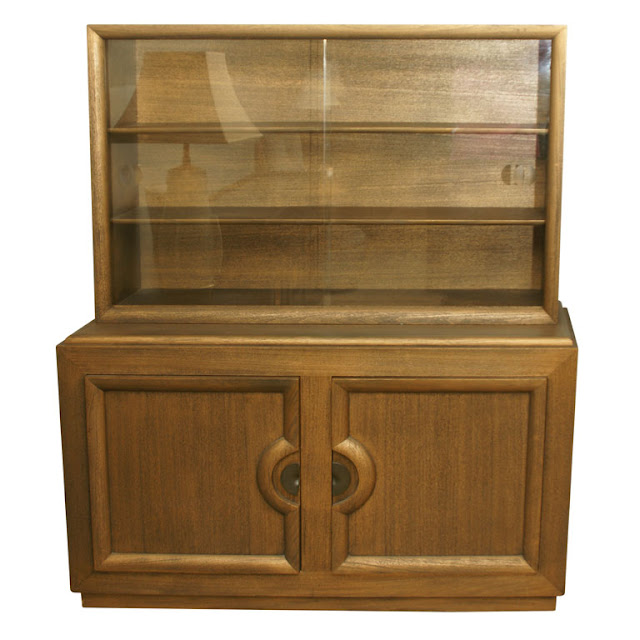 |
| Edward Wormley side table griffintrading.com |
 |
| Gilbert Rohde Paldao table, with one leg and one plinth base treadwaygallery.com |
 |
| Harvey Probber night stand 1stdibs.com |
 |
| Milo Baughman night stands metroretro.com |
 |
| Renzo Rutili credenza metroretro.com |
 |
| T. H. Robsjohn-Gibbings double plinth base table 1stdibs.com |
 |
| Peter Hvidt chest lookmodern.com |
 |
| Paul Lazlo cabinet 1stdibs.com |
 |
| Paul Evans credenza galere.net |
 |
| Paul Evans sofa galere.net |
 |
| Milo Baughman chairs 1stdibs.com |
 |
| Vladimir Kagan Serpentine sofa edition20.com |
This is a contemporary sofa designed by Vladimir Kagan in 1999, but I just had to include it in this post. The piece may not fall into the mid-century time frame, but Kagan opened his first shop in 1949 and has been designing gorgeous furniture for decades. Since this sofa appears to be a variation on his 1950 Serpentine sofa, it definitely deserves a look, in my opinion.


My 50's stuff is plinthing, my 80's furniture is plinthing too lol.
ReplyDelete(I thought a "plinth" was something tapered or a tapered design, or like a shim or wedge... See how little I know?)
:)
our contractor in india called it skirting :)..but i would rather have my furniture stand on legs for easy cleaning and an airy feel!
ReplyDeleteI learn something new yet again, thanks. Bilbao sofa, I want you!
ReplyDelete@sudha: I agree that legs provide a much more open feel to a room. The only plinth based piece I own is my corner china cabinet.
ReplyDelete@1950sarh: I wasn't familiar with the term either till someone asked me the other day what that style of furniture is called, so I did a little research.
ReplyDelete@I dream lo-tech: Isn't that Bilbao a stunner? I love the back!
ReplyDeleteGreat post Dana but it does pose an interesting question: What is the definition of "mid-century"? :-)
ReplyDeleteThanks for the post!
ReplyDelete@joeegg007: I almost dedicated it to you and your schifs or whatever...:)
ReplyDeleteGreat question, Jonathan. If you and I could answer that one today, we'd be famous, since so many before us have tried and failed to agree.
ReplyDeleteWhen I first became interested years ago, I thought mid-century meant 1950s and googie...hard to believe I was ever that green...but I daresay many of those "50 people on the street" might have just as narrow a view of the style as I did.
Today I tend to think of mid-century more in terms of a rejection of the superfluous ornamentation of "period" furniture in favor of clean lines, functionality and affordability...and a belief that less could definitely be more. But then that would leave out Paul Evans, whom I consider a mid-century designer because of his work with Phillip Lloyd Powell, which is why I often include photos of his work done in the 70s. If I had to be pinned down on a time frame, I'd say 1930s through the mid-60s, but, on the front end, that leaves out pieces like the Wassily and Basculant chairs. But, but, but. See, I can't even agree with myself on a definition, and I'm starting to sound a lot like Justice Potter "I Know It When I See It" Stewart. It's true though...mid-century to me is more about a feeling/mindset than a set of parameters, as obvious and lame a cop-out as that is. :)
I'd love to hear your thoughts, because I'm sure you've had to give that quite a bit of consideration as you've been working on your book and will have a much more articulate response than I did.
Nothing inarticulate about your response here Dana!
ReplyDeleteFor me the Mid-Century period encompasses the years from 1945-1955 or possible until 1959 but no later. It was between 45-55 that american contemporary design was happening (note I say contemporary, and not mid-century modern). After 1955 there was a huge design backlash as the next generation of new homeowners rejected the new american contemporary design movement for period reproductions and various european and african influenced designs such as the mediterranean influenced collections by Robsjohn-Gibbings for Widdicomb of the late 50's.
After 1955 it seemed to many that the american contemporary movement was over, certainly the death of american contemporary movement was written about more than once post 1955. American contemporary design still kept going however in offices and other places of public assembly. Responding to the new realities of their business the major manufacturers shifted their focus from designer showrooms for the home decorator to designer showrooms for the contract decorator. I think you'll see exactly what I mean if you take a careful look at Herman Miller, Knoll and many others post 1955. But certainly the energy had gone out of it post 1955.